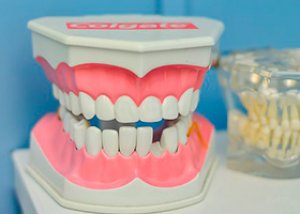
All iLive content is medically reviewed or fact checked to ensure as much factual accuracy as possible.
We have strict sourcing guidelines and only link to reputable media sites, academic research institutions and, whenever possible, medically peer reviewed studies. Note that the numbers in parentheses ([1], [2], etc.) are clickable links to these studies.
If you feel that any of our content is inaccurate, out-of-date, or otherwise questionable, please select it and press Ctrl + Enter.
Analysis of the mandible prior to implant insertion
Medical expert of the article
Last reviewed: 08.07.2025
 ">
">The presence of an underdeveloped chin is the most common indication for its augmentation. The basic principles of aesthetic facial proportions have been summarized by Powell and Humphreys; they include frontal and lateral assessment. The face in AP projection can be divided into thirds, the lower of which is bounded by the subnasale and menton. This, in turn, can be divided into thirds so that the upper third is between the subnasale and the upper stomion, and the lower two-thirds are between the lower stomion and menton. With age, there is a decrease in the vertical height and anterior protrusion of the mandible, resulting in a loss of ideal proportion. To determine the underdevelopment of the chin in the lateral view, the Gonzales-Ulloa method can be used. This technique defines the protrusion of the chin as aesthetic when the anterior soft tissue point of the chin, the pogonion, touches a vertical line dropped from the nasion, perpendicular to the Frankfurt plane. If the chin is located posterior to this line and there is a Class I occlusion, an underdeveloped chin is diagnosed. An underdeveloped chin may be the result of microgenia, a small chin resulting from underdevelopment of the mandibular symphysis, or micrognathia due to hypoplasia of various parts of the mandible. Mandibular augmentation is usually performed for microgenia and cases of mild micrognathia. The patient's bite is assessed most carefully. Augmentation is most appropriate for patients with microgenia and a normal or nearly normal bite.
Although congenital factors contribute to the presence of chin hypoplasia, the development of the anterior mandibular groove is primarily a consequence of age-related changes. Loss of elasticity in the skin of the eyelids, face, neck, and submental area are the most obvious and frequently observed signs of aging. Subtle changes in the configuration of the anterior mandibular region also occur, which can have a significant impact on facial appearance. As a result of progressive soft tissue atrophy and gradual bone loss in the area between the chin and the lateral portions of the mandible, patients may develop a groove between the chin and the rest of the mandible, known as the anterior mandibular groove.
There are two main factors that contribute to the formation of the anterior mandibular groove with age. The first is the resorption of the bone tissue of the mandible at the junction of its central (chin) and anterolateral parts. Anatomy texts show that the area below the mental foramen is resorbed and becomes concave. This is called the anterior mandibular groove. This groove, located on the surface of the bone, is reflected on the outer surface of the soft tissues as a notch between the buccal part of the mandible and the chin and is called the anterior mandibular groove. The other major factor in the formation of the anterior mandibular groove is the atrophy of the soft tissues in this area with aging. Over time, this line becomes part of the oval that outlines the mouth and is called the "marionette line" or "bib line." In most people who develop a premaxillary groove with age, it is often the result of a combination of soft tissue atrophy and bone resorption in the area between the chin and the buccal portions of the mandible.


 [
[